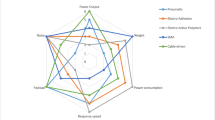Abstract
The machine tool industry has to overcome many challenges to produce efficient, high performance and precise machine tools. These requirements are directly from the customers, who want the ability to produce more cost-effective. In order to achieve this, the machine parameters such as the feed rate or the depth of cut of grinding machines are increased. These new parameters affect the dynamic behavior of the machine tool, and in some cases can result in extreme vibrations. These vibrations can generate chatter marks on the workpiece surface or limit the ability to obtain a stable process. This article deals with an active approach to reduce possible vibrations within machine tools. Here the tool holding device of a surface grinding machine has been extended to create an active tool holding device. The active design allows the manipulation of the dynamic behavior of a surface grinding machine, allowing the implementation of a better parameter set.









Similar content being viewed by others
References
Insaki I, Kerpuschewski B, Lee H-S (2001) Grinding chatter—origin and suppression. Ann CIRP 50:515–534
Hesselbach J (2011) Adaptronik für Werkzeugmaschinen: Forschung in Deutschland. Shaker Verlag, Aachen
Pahl G, Beitz W (2007) Konstruktionslehre, vol 7. Auflage, Berlin
Simnofske M, Raatz A, Hesselbach J (2009) Design process for adaptronic machine tools. Prod Eng 3:461–468
Boldering A, Simnofske M, Raatz A, Hesselbach J (2011) Schleifmaschine mit adaptronisch erhöhter statischer und dynamischer Steifigkeit. Hesselbach: Adaptronik für Werkzeugmaschinen: Forschung in Deutschland. Shaker Verlag, Aachen, pp 46–66
Weinert K, Biermann D, Iovkov I, Kerting M (2011) Aktive Dämpfung von Ratterschwingungen beim Einlippentiefbohren. Hesselbach: Adaptronik für Werkzeugmaschinen: Forschung in Deutschland. Shaker Verlag, Aachen, pp 244–262
Munzinger C, Weis M, Herder S (2008) Adaptronic hydrostatic guiding system for intelligent level control of machine tool slides. Adaptronic Congress, Berlin, pp 193–198 (Mai 2008)
Verl A, Heinze T (2011) Adaptronische Schwingführung—Linearführungssystem mit adaptivem Reibverhalten Hesselbach: Adaptronik für Werkzeugmaschinen: Forschung in Deutschland. Shaker Verlag, Aachen, pp 263–279
Hesselbach J, Hoffmeister H-W, Schuller B, Simnofske M (2005) Adaptronik für Werkzeugmaschinen. Adaptronic Congress, Göttingen
DIN ISO (1999) 603-4 Schleifkörper aus gebundenem Schleifmittel. Teil, vol 4: Schleifmittel für Flachschleifen/Umfangsschleifen. Beuth Verlag, Berlin (Mai 2000)
Simnofske M (2009) Werkzeugaufnahme. DE102009031428.8, date of filling: 01.07.2009. German Patent and Trademark Office, München
Acknowledgments
The authors gratefully acknowledge the funding of the reported work by the German Research Foundation (DFG) within the project Ra 1736/5-1.
Author information
Authors and Affiliations
Corresponding author
Rights and permissions
About this article
Cite this article
Boldering, A., Raatz, A. An active tool holding device. Prod. Eng. Res. Devel. 6, 513–520 (2012). https://doi.org/10.1007/s11740-012-0402-x
Received:
Accepted:
Published:
Issue Date:
DOI: https://doi.org/10.1007/s11740-012-0402-x




